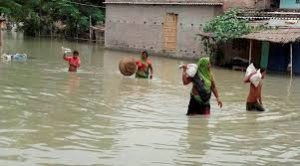Natural hazards and other related aspects of Bihar
Major Natural hazards of Bihar state includes:
- Earthquake
- Floods
- Drought
It also suffers from heat wave and cold wave. We will see about these one by one here:
Earthquake
Bihar is situated in the high seismic zone that falls on the limit of the structural plate joining the Himalayan structural plate close to the Bihar-Nepal Border and has six sub-surface blame lines moving towards the Gangetic planes in four ways.
Of the 38 regions of Bihar, 8 areas fall in seismic zone V of which 2 locale (Madhubani and Supaul) fall totally in seismic zone V while 24 regions fall in seismic zone IV and 6 regions in seismic zone III with most regions falling under various seismic zones (i.e. either seismic zone V and IV or seismic zone IV and III).
The state has in the past experienced real seismic tremors; the most noticeably bad was the 1934 quake in which more than 10,000 individuals lost their lives, trailed by 1988 quake and late seismic tremor was the Sikkim seismic tremor in September 2011.
The new and developing urban focuses in the state where construction laws and control systems are not implemented, quake remains a noteworthy danger to urban communities. This could bring about social frameworks, for example, schools and healing centers that are not worked to be tremor safe could prompt work well for harm and loss of lives as.
Floods
Bihar’s geography is set apart by various lasting and non-perpetual waterways of which, those starting from Nepal are known to convey high dregs stacks that are then kept on the fields of Bihar. A larger part of the precipitation in this district is packed in the 3 months of storm amid which the stream of waterways increments up to 50 times causing surges in Bihar. As per the Bihar Government’s Flood Management Information Systems Cell, surges of Bihar can be separated into 4 classes to be specific:
Class I: Flash floods– surges happening because of precipitation in Nepal, lead time is short (8 hours), subsiding of surge waters is quick;
Class II: River floods– lead time 24 hours, subsiding of surge waters is 1 week or more;
Class III: Drainage blockage in waterway juncture lead time over 24 hours, enduring full rainstorm season (i.e. subsiding of surge water takes 3 months).
Class IV: Permanent water logged range.
All things considered, 73.63% of the geological region of North Bihar is thought to be inclined to floods. Out of 38 areas, 28 locale get overflowed (of which 15 regions are most exceedingly bad influenced) causing gigantic loss of property, lives, farmlands and foundation. Amid the 2008 Kosi surges, more than 350,000 sections of land of paddy, 18,000 sections of land of maize and 240,000 sections of land of different products were antagonistically influenced, affecting near 500,000 agriculturists.
Drought
Without satisfactory precipitation, most piece of Bihar including North Bihar which is inclined to surges faces dry spell circumstances. South and South West Bihar are more powerless and regularly encounters extreme dry spell circumstances. Locale of Munger, Nawada, Rohtas, Bhojpur, Aurangabad and Gaya are the known dry season inclined territories of the state.
In spite of the fact that the atmosphere of Bihar is great for generation of different yields, the horticulture of the state is reliant on conduct of rainstorm and dispersion of precipitation. In spite of the fact that the normal precipitation in the state is 1120 mm, significant varieties happen between the diverse parts of the State. Substantial piece of the state is presently progressively helpless against dry season because of environmental change. Without satisfactory precipitation, most piece of Bihar including North Bihar which is inclined to surges faces dry spell circumstances. South and South West Bihar are more helpless and frequently encounters extreme dry season circumstances
Other Hazards
Aside from the above perils, the state is likewise inclined to heat and cold waves, Cyclonic tempests (fast breezes) and other human-instigated dangers like fire, pandemics, street/vessel mishaps, rushes and so forth. Rates of flame are primarily nearby in nature howeversevery affect towns. Since a larger part of Kucha houses have cover rooftops and wooden structures, in the late spring months when winds are high, fires from the conventional stoves spread to harm whole towns.
Activities of BSDMA towards making catastrophe strong Bihar
Despite the fact that the state is a multi-risk inclined state, it has additionally been moving towards more noteworthy calamity versatility. Bihar State Disaster Management Authority (BSDMA), together with Disaster Management Department of Government of Bihar, has been taking different activities towards mindfulness age and limit working of different partners and furthermore the influenced populace. Accentuation of BSDMA has been towards basic and non-basic reinforcing of the framework to lessen catastrophe chances and alleviate their effects. Wellbeing Weeks (Road Safety, Earthquake Safety, Fire Safety and Flood Safety), preparing of partners, safe school programs, safe development rules, Free Earthquake Safety Clinic and Center, wide course of IEC materials and so on are a portion of the essential activities of the Authority.
BPCS Notes brings Prelims and Mains programs for BPCS Prelims and BPCS Mains Exam preparation. Various Programs initiated by BPCS Notes are as follows:-